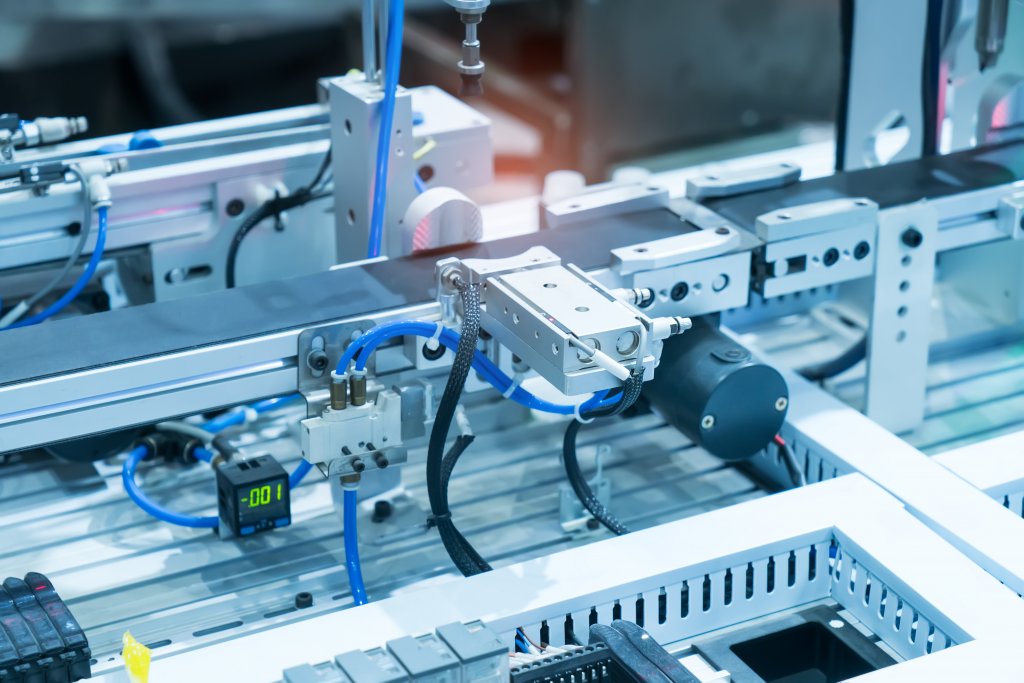Optimizing Pneumatic System Design for the Best Performance
In pneumatic systems, pressurized air generates motion that is used to drive automated equipment, manufacturing processes and air-powered tools and devices in a reliable and cost-effective way. But to achieve top-notch performance in any application, properly designed air systems are a must. This blog will explore and explain pneumatic systems and how careful selection of components and thoughtful air system design can optimize pneumatic system operation.
What is a Pneumatic System?

A pneumatic system typically draws ambient air into an air compressor where pressure is applied in a way that safely compresses the air and generates force that can be converted into energy, enabling the movement and control of mechanical devices.
Key components within a pneumatic system include the air compressor, air treatment, valves and actuators or cylinders that work together to create and direct motion to the end use point, which can be anything from a valve in a manufacturing process to a robotic arms end of arm tooling to a nail gun to a medical device.
To operate, a pneumatic system works as follows:
- Air is drawn into the air compressor and is treated to remove contaminants.
- The air is compressed, cooled, dried and stored until needed.
- When there is demand, treated air moves through an air delivery system of pipes or tubing toward directional control valves.
- The control valves direct and control the flow of air to actuators and other pneumatic equipment.
- Actuators or cylinders then convert the pressurized air into energy, enabling mechanical motion to open valves, rotate motors, move pistons or complete other mechanical tasks at the end point.
In addition to pneumatic system components such as the air compressor, valves, and actuators mentioned above, properly designed air systems should include:
- Filters, coolers, air dryers and drains to remove contaminants and impurities.
- Piping or tubing for delivering compressed air through the pneumatic system.
- Pressure regulators to maintain safe and efficient pressure levels.
- A reservoir tank for storing treated compressed air.
5 Tips for Optimal Pneumatic Design
While a pneumatic system can provide a cost-effective and reliable source of power for industrial, manufacturing, automation and other applications, it is only as good as the air system design.
Pneumatic design requires careful selection and sizing of key system components and proper pressure levels to assure safety, energy efficiency and optimal performance.
Below you will find 5 tips for optimizing air compressor system design:
1. Properly size the air compressor and delivery system
Ensure that the air compressor piping or tubing are adequately sized for the application requirements. Undersized air compressors and piping will result in pressure that is too low and will have a negative impact on the performance of the end point tools and devices, as well as the energy efficiency of the system. Conversely, when these components are oversized, it can result in high levels of energy consumption and wear and tear on the equipment as the compressor will likely cycle on and off too frequently if it is too large. More information on sizing an air compressor is available here.
2. Carefully select and size actuators or cylinders
The type of technology required will depend upon the application. However, when sizing the actuator or cylinder, the load or force requirement will determine the proper size. These components should not be oversized or it can reduce the energy efficiency of the pneumatic system. A good rule of thumb is to have about 25% more force available than the estimated requirements. Speed should also be considered when selecting these components and should match the specifications of the application. Again, choosing a speed that moves a load too fast will negatively affect performance and efficiency, while an actuator that moves too slow will not provide optimal operation at the end point.
3. Choose the right type of control valve
The type of control valve and its flow capacity should be selected based on the flow rate and pressure requirements of the application, as well as the cylinder or actuator being used in the system. Directional control valves may be solenoid-operated, air-piloted or manually operated and are available with multiple port configurations to control air flow and actuator or cylinder activation as needed for the application. Additional information on selecting a control valve can be found here.
4. Use moisture removers and filters
The act of compressing air generates moisture, which can damage the pneumatic system and the end point devices. Intake filters will help remove contaminants and impurities from the ambient air as it is drawn into the pneumatic system. Filters should be cleaned or changed on a regular basis as clogged filters will result in blockages that inhibit the efficiency and performance of the pneumatic system. Air coolers, dryers and drains will serve to remove corrosion-causing moisture, preventing damage to system components and air-powered tools and equipment. For more details on air dryers, see this blog.
5. Operate at and maintain required system pressure
Pneumatic systems should be designed based upon the component with the lowest maximum pressure rating to ensure safe operation. Ancillary equipment such as pressure regulators, relief valves or pressure control valves should be used to control and maintain system pressure for safe, efficient and effective operation. Pressure regulators , and relief valves not only ensure safe operation and optimal performance, but also protect pneumatic system components and end-use equipment from damage caused by overpressurization.
Careful specification of pneumatic system components and thoughtfully designed air systems will ensure optimal performance, better energy efficiency and safe and reliable operation of the air compression system and end-point equipment. For assistance with air compressor system design or component sizing and selection, please contact the pneumatic system experts at JHFOSTER, a Tavoron company.
